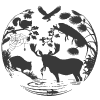
CNS Resources
The Digestive System of Vertebrates
Introduction
Present-day vertebrates are comprised of approximately 45,000 species of fish, amphibians, and reptiles, birds and mammals that have adapted to a wide range of diets and habitats. Their digestive system provides for the assimilation of nutrients by a complex series of episodic events that reduce food to a limited number of readily absorbable nutrients. Many of the basic characteristics of the vertebrate digestive system are common to all species. However, its various components show numerous structural and functional adaptations to the habitat, diet, energy requirements, and other characteristics of the animal. Some of these adaptations are the result of divergence from a common or more primitive form. Others represent convergence on similar structures or functions in distantly related species. An understanding of these adaptations is necessary for the care and maintenance of domesticated and captive animals, and the preservation of endangered species. These adaptations also tell us a great deal about the basic functions of the digestive system, their integration with other functions of the body.
Much of our knowledge and understanding of the digestive system has been derived from studies of comparative physiology. Studies of Na+ transport across the frog skin laid the groundwork for determining the complex mechanisms for the secretion and absorption of electrolytes. The contributions of indigenous gut microbes to the production and conservation of nutrients were first determined from early studies of the ruminant forestomach. Studies conducted on fish, amphibians, reptiles, and birds have provided insight on the digestive enzymes, mechanisms of nutrient absorption, motor activities, and neuroendocrine control of the digestive system, and how they evolved.
The applications of this information to the care and maintenance of agricultural, companion, laboratory, and captive animals are obvious. However, one of most compelling reasons for the study of comparative physiology is the need to preserve endangered species. Paleontologists have recorded six massive and numerous other major extinctions of plants and animals over the past 500 million years. These extinctions were largely the result of tectonic and climatic changes that occurred over relatively short periods of geological time. The most recent massive extinction, about 65 million years ago, has been attributed to the catastrophic impact of a meteor. The most recent major extinction of large mammals, at the end of the last Ice Age, around 11,000 years ago, has been attributed to both climatic changes and predation by humans (Owen-Smith 1988; Alroy 2001; Roberts et al. 2001). However, most biologists believe that our planet is approaching another massive extinction of plants and animals precipitated by humans alone.
An analysis of global ecosystems by the United Nations Environmental and Development Program, World Resources Institute, and World Bank (Rosen et al. 2000) shows that human consumption of freshwater rose six-fold in the past century and we now use 54% of that available. Silts, fertilizers, sewage, and other contaminants have killed lakes and poisoned rivers, and the introduction of nonnative plants and animals has destroyed many indigenous species or clogged the waterways. The Colorado, Yellow, and Ganges rivers dry up at times before reaching the sea. Two-thirds of all harvested fish are dependent on coastal wetlands and seas, or coral reefs at some stage in their development. Yet, half of the world’s wetlands have been drained and pollution and plant nutrient runoffs produce algae blooms and other conditions that have resulted in the complete absence of fish and invertebrates in some regions of coastal waters.
Our global forests are inhabited by about two-thirds of all terrestrial species and store 40% of the terrestrial CO2. Rain forests, which cover 6% of earth’s surface, contain most of these species. Yet, almost all of the original forests of industrial nations other than Russia and Canada have been cleared. Logging in developing countries is faster than tree growth and much of the rain forest has been destroyed by logging or by slashing and burning for agriculture. The UN report concludes with a summary of the economic, moral, and ethical reasons for addressing these problems, but points out that many multimillion-dollar attempts have failed because we simply do not know enough about the needs and interrelationships of plants and animals.
This CD is patterned after the second edition of Comparative Physiology of the Vertebrate Digestive System (Stevens & Hume 1995), and a course taught at Cornell and North Carolina State University. It is designed for use by physiologists, zoologists, nutritionists, veterinarians, and others interested in the digestive functions. Many variations in the digestive system can be attributed to adaptations to the habitat, diet, energy requirements, or other physiological characteristics of the species. Therefore, this CD begins with discussions of the taxonomic classifications, diets, and distribution of vertebrates, their basic energy requirements, and the general characteristics of their digestive system. The subsequent sections discuss variations in the structural and functional characteristics of the vertebrate digestive system and how they may have evolved. A Table of Contents and Index allow rapid retrieval of text, photographs, figures, and tables by subject and species for viewing or presentation. References to texts, reviews, and other sources are provided for more detailed or extensive coverage of these subjects.
Next section: Classifications, Diets, & Distribution
